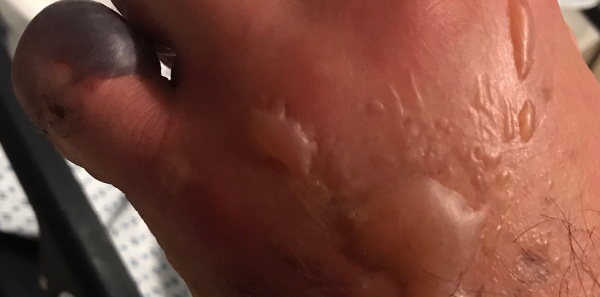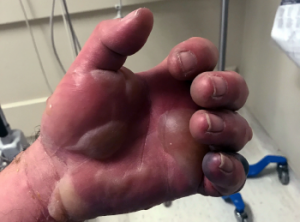
The Case
A 60-year-old male with past medical history of anxiety and depression presented to the emergency department via EMS with complaints of pain in the left upper extremity after falling. The patient stated he recently moved into a new apartment, and he tripped and fell forward onto a carpeted surface three days ago. He then developed pain and swelling to the left hand/arm and left eye. He reported loss of consciousness for some time and denied any alcohol or drug use or abuse. The patient noted the redness to his left hand yesterday, and it progressively worsened and started to develop blisters (see Figures 1 and 2). The patient also noted swelling to the left eye upper and lower eyelids and a rash to the left upper abdomen similar in appearance to his hand (see Figures 3 and 4). He admitted to significant pain and stated he could not straighten his fingers. He denied fever, chills, nausea, vomiting, chest pain, shortness of breath, or similar symptoms in the past. He hadn’t taken anything for pain.
Explore This Issue
ACEP Now: Vol 37 – No 10 – October 2018
Figure 2: Rash and blisters on the patient’s left hand.
Based on his history and physical exam, a CT of the head, maxillofacial, and left hand without contrast were ordered because of concern for necrotizing fasciitis and compartment syndrome. His chemistries were significant for sodium 126 mEq/L, potassium 6.4 mEq/L, blood urea nitrogen 77 mg/dL, creatinine 6.85 mg/dL, glucose 109 mg/dL, total creatinine phosphokinase 11,000 U/L, aspartate aminotransferase 871 U/L, alanine aminotransferase 972 U/L, white blood cell count 13.5 k/mm3 with left shift, hemoglobin 15.2 g/dL, and C-reactive protein (CRP) 249.2mg/L.
The head CT was negative for acute findings. The maxillofacial CT was significant only for soft tissue swelling. The CT of the left hand was notable for osteoarthritis of the left trapezium and first and second metacarpals with some soft tissue swelling with blebs in subcutaneous soft tissues. Plain radiographs of the hand were significant for flexion deformities of the distal phalanges. However, no subcutaneous air or acute fracture or dislocations were noted. X-rays of the right hip and chest were negative for acute findings.
Over the course of his ED visit, the patient became more uncomfortable, and the pain and functionality of his left hand worsened since his arrival. Reexamination showed numbness to the left hand and forearm and a weak radial pulse, both of which were concerning signs for compartment syndrome. Orthopedic surgery was consulted, and the patient was emergently taken to the operating room (OR) for debridement and fasciotomy of the left hand and forearm. Compartment pressures were not measured as the patient exhibited clinical signs of compartment syndrome and delaying definitive treatment to measure compartment pressure is contraindicated. The patient was started on clindamycin, Zosyn, and vancomycin. He was taken to the OR the following day for a second debridement, and a muscle biopsy was performed of the left volar region, identifying viable skeletal muscle tissue with mild reactive changes. The patient underwent hemodialysis for acute renal failure secondary to rhabdomyolysis. The patient had a long, complicated hospital course. Ultimately, he improved and was discharged to a rehabilitation facility on day 20.
Pages: 1 2 3 | Single Page





No Responses to “Necrotizing Fasciitis Requires Rapid Diagnosis and Treatment”